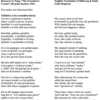6: Song, “The Greenhorn Cousin” ("Di grine kuzine"), 1921.
Much American Jewish literature from the height of the Immigration Era expresses the difficulties and disillusionments of the immigrant experience, from the sweatshop poetry of Morris Rosenfeld to the modernist fiction of Henry Roth. This resource, the 1921 song “The Greenhorn Cousin” ("Di grine kuzine"), tells the story of a newly-arrived immigrant through the eyes of her more experienced cousin. It offers a useful point of comparison for the experiences of Sholem Aleichem’s characters.
Suggested Activity: Distribute the transliterated Yiddish lyrics and their English translation. Have students follow along as they listen to the song. Ask students to quickly trace the plot arc of its title character. What does she experience? What tone does the song take toward immigration to the United States? Now compare this song with the story of the newly-arrived (“greenhorn”) immigrants in Motl’s family. Does this reflect their experiences? In what ways? How do they respond to these experiences—and if this is different from the song, why might that be so? Think for a moment about the different relationships to “Columbus’ country” presented by the song and by Pinye. Why is Pinye able to retain his idealistic belief in this concept? Sholem Aleichem is known for using humor to approach sorrowful topics, and Motl is no exception. Do students find humor in “The Greenhorn Cousin”? Where? How does it compare to Sholem Aleichem’s use of humor?
Sources: Abe Schwartz and Hyman Prizant, Di grine kuzine (The Greenhorn Cousin), Abraham Moskowitz with unknown clarinetist, Abe Schwartz, violin and Sylvia Schwartz, piano, recorded February 1922, accessed through the Max and Frieda Weinstein Archive of YIVO Sound Recordings, 2019.
Lyrics from yidlid.org with edits by Sadie Gold-Shapiro to match the recorded audio, accessed November 2019.

